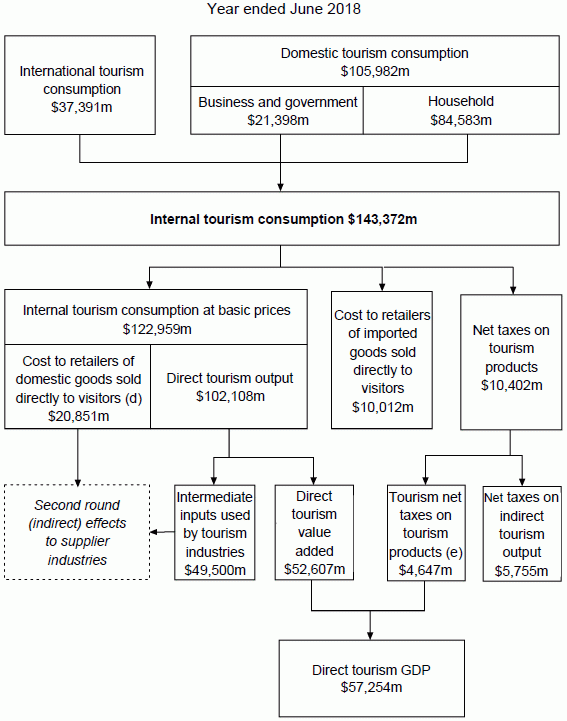Revisions are a necessary and expected part of accounts compilation as data sources are updated and improved over time. It is standard practice in National Accounts benchmarking to review all source data and incorporate revisions.
The TSA methodology usually involves estimating a full benchmark every third year. When a new benchmark reference year is added, it normally has a two year lag in relation to the latest reference year for the TSA (in this case 2017-18). In this release, the new benchmark reference year has been moved forward to 2016-17 (rather than 2015-16) so that the benchmark is one year closer to the most recent reference year period. See the Explanatory Notes for a description of the benchmark methodology.
As part of the 2016-17 benchmark process, the relationships (coefficients) established in 2012-13 have been reviewed and adjusted. In addition, coefficients from the 2009-10 and 2006-07 benchmarks have also been updated and revised as required to ensure consistent time series.
Latest industry data, Supply and Use tables and other input data series have been incorporated into this release and have resulted in a range of revisions across the time series. This release also incorporates revised data on international visitors, nights and spend estimates between 2005 to 2018 from Tourism Research Australia published in International Visitor Survey (IVS) for Year Ending December 2018. Furthermore, improvements to estimation methods listed in the Changes in this issue section have also resulted in revisions. These revisions include the following:
- Estimates of tourism consumption and output have been revised following confrontation between demand and supply side data in the 2016-17, 2012-13, 2009-10 and 2006-07 benchmark reference years with targeted adjustments. These include Accommodation services, Airfares, Takeaway and restaurant meals and Travel agency and information centre services.
- Estimates of outbound tourism consumption have been revised as a consequence of revisions to 5368.0 - International Trade in Goods and Services, Australia, Sep 2018, and through further revisions noted below for international and domestic consumption.
- Estimates of international tourism consumption have been revised as a consequence of improvements made to estimation methods for particular products and incorporation of updated data sources. This has resulted in major revisions for:
- Travel agency and information centre services product - including upward revisions to the level of the series which involved a reallocation of expenditure from some other tourism products as well as new estimates on services provided by tourist information centres to international visitors.
- International airfares - with improvements to current estimation methods (re-allocation of package tour, organised tour and conference fee) and incorporating revisions to Other personal travel as published in 5368.0 - International Trade in Goods and Services, Australia, Aug 2016 from 2012-13 onward.
- Education services - including improved modelled estimates for short-term student visitors (stay less than 12 out of 16 months) between 2005-06 to 2016-17.
- Motor vehicle, caravan and boats etc - through updated methodology to better estimate removal of second-hand purchases based on more detailed data captured by TRA in their International Visitor Survey.
- Estimates of domestic tourism consumption have also been revised as a consequence of improvements made to estimation methods for particular products and the incorporation of updated data sources. This has resulted in major revisions for:
- Domestic airfares - through improved estimates (across the time series) on domestic airfares undertaken by travellers prior to an international trip.
- Travel agency and information centre services - including upward revisions to the level of the series which involved a reallocation of expenditure from some other tourism products as well as new estimates on services provided by tourist information centres to national visitors..
- Recreational, cultural and gambling services - mainly driven by updated methodology to account for imputed values of non-market services provided directly to visitors such as public museums (refer to Explanatory Notes, para 25), and improved methodology for estimating gambling expenditure by domestic visitors.
- Outbound expenditure, that is expenditure by Australians travelling abroad on goods or services provided on Australian domestic territory (either before or after the trip), has been revised following improvements made to estimation methods for particular products. Refer to Explanatory Notes, para 24 for more information on outbound expenditure.
- Estimates of Imputed and actual rent on holiday homes used by international and domestic visitors have been revised due to revisions to the dwelling stock number published in 5204.0 - Australian System of National Accounts, 2017-18.
- Estimates of tourism employment and hours worked have been revised throughout the whole time series due to multiple factors. These include:
- Revisions to Labour Force Survey (LFS) data due to major re-benchmarking to align with the latest population numbers. Further information can be found at 6202.0.55.003 - Labour Force, Australia - Rebenchmarked Estimates, October 2017
- Updated seasonal analysis factors have been incorporated in all periods to reduce the variability in the tourism industry estimates. For more information, refer to Explanatory Notes section, para 79.
- Revisions to tourism industry value-added for all industries due to re-benchmarking (for 2012-13, 2009-10 and 2006-07), which have resulted in changes to the value added ratios applied to the LFS data across the whole time series.
As usual economy wide national accounting aggregates have been revised across the entire series to ensure consistency with published estimates in the 2017-18 issue of Australian System of National Accounts (cat. no. 5204.0) published on 26 October 2018. These revisions affect tourism shares of GDP and GVA presented in Tables 1, 2, 5, 6 and 10 of the TSA.
Note also that revisions to the level of the entire series for the tourism chain volume estimates are an expected part of re-referencing the indexes to equal 100 in the latest reference year (2016-17).
